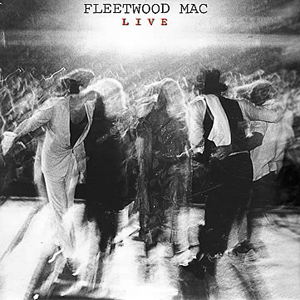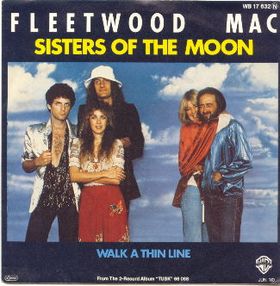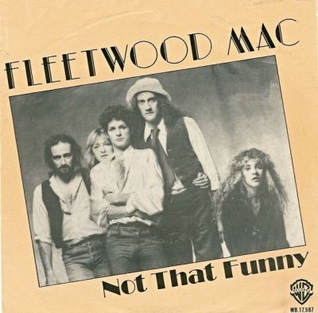
Tusk is the twelfth studio album by British-American rock band Fleetwood Mac, released as a double album on 12 October 1979 in the United States and on 19 October 1979 in the United Kingdom by Warner Bros. Records. It is considered more experimental than their previous albums, partly as a consequence of Lindsey Buckingham's sparser songwriting arrangements and the influence of post-punk. The production costs were initially estimated to be about $1 million but many years later were revealed to be about $1.4 million, making it the most expensive rock album recorded to that date.

Fleetwood Mac is the tenth studio album by British-American rock band Fleetwood Mac, released on 11 July 1975 in the United States and on 1 August 1975 in the United Kingdom by Reprise Records. It is the band's second eponymous album after their 1968 debut album and is sometimes referred to by fans as the White Album. It is the first Fleetwood Mac album with Lindsey Buckingham as guitarist and Stevie Nicks as a vocalist, after Bob Welch departed the band in late 1974. It is also the band's last album to be released on the Reprise label until 1997's The Dance; the band's subsequent albums until then were released through Warner Bros. Records, Reprise's parent company.

Mirage is the thirteenth studio album by British-American rock band Fleetwood Mac, released on 2 July 1982 by Warner Bros. Records. This studio effort's soft rock sound stood in stark contrast to its more experimental predecessor, 1979's Tusk. Mirage yielded several singles: "Hold Me", "Gypsy", "Love in Store", "Oh Diane", and "Can't Go Back".

The Dance is a live album by the British-American rock band Fleetwood Mac, released on 19 August 1997. It hailed the return of the band's most successful lineup of Lindsey Buckingham, Mick Fleetwood, Christine McVie, John McVie, and Stevie Nicks, who had not released an album together since 1987's Tango in the Night, a decade earlier. It was the first Fleetwood Mac release to top the U.S. album charts since 1982's Mirage.

"Don't Stop" is a song by British-American rock band Fleetwood Mac, written by vocalist and keyboardist Christine McVie. The song was sung by guitarist Lindsey Buckingham and Christine McVie, and it was a single taken from the band's hit album Rumours (1977).

"Dreams" is a song by British-American rock band Fleetwood Mac, written by singer Stevie Nicks for the band's eleventh studio album, Rumours (1977). In the United States, "Dreams" was released as the second single from Rumours in March 1977, while in the United Kingdom, the song was released as the third single in June 1977. A stage performance of "Dreams" was used as the promotional music video.

"Go Your Own Way" is a song by British-American rock band Fleetwood Mac from their eleventh studio album, Rumours (1977). The song was released as the album's first single in December 1976 in the United States. Written and sung by Lindsey Buckingham, it became the band's first top-ten hit in the United States. "Go Your Own Way" has been well received by music critics and was ranked number 120 by Rolling Stone magazine on their list of 500 greatest songs of all time in 2010, and re-ranked number 401 in 2021. They also ranked the song second on their list of the 50 greatest Fleetwood Mac songs.
"Second Hand News" is a song written by Lindsey Buckingham. The song was first performed by the British-American rock band Fleetwood Mac as the opening track of their 1977 album Rumours.
"The Chain" is a song by British-American rock band Fleetwood Mac, released on their 1977 album Rumours. It is the only song from the album with writing credits for all five members.

"You Make Loving Fun" is a song by British-American rock band Fleetwood Mac, written and sung by Christine McVie. It was released as the fourth and final 45 rpm single from the band's 1977 album Rumours. "You Make Loving Fun" peaked at No. 9 on the US Billboard Hot 100 and became the album's fourth top-ten hit.

Live is a double live album released by British-American rock band Fleetwood Mac on 5 December 1980. It was the first live album from the then-current line-up of the band, and the next would be The Dance from 1997. The album was certified gold by the RIAA in November 1981. A deluxe edition of the album was released on 9 April 2021.
"The Ledge" is a song by British-American rock band Fleetwood Mac, released in 1979. It is the second song from the multi-platinum Tusk album and was composed by Fleetwood Mac guitarist Lindsey Buckingham. The band rehearsed “The Ledge” several times for the Tusk Tour, although it was ultimately not included in the set.

"Sara" is a song written by singer-songwriter Stevie Nicks of the British-American rock band Fleetwood Mac, which was released as a single from the 1979 Tusk double LP. The vinyl album version length is 6 minutes 22 seconds, and the edited single version length is 4 minutes 37 seconds. The song peaked at No. 7 in the US for three weeks, No. 37 in the UK for two weeks, No. 11 in Australia, and No. 12 in Canada.

"Sisters of the Moon" is a song by British-American rock group Fleetwood Mac. It was written and sung by band-member Stevie Nicks and was released in the US as the fourth single from the 1979 album Tusk. The song peaked at No. 86 on the Billboard Hot 100, although it was not released in the UK. The single version of "Sisters of the Moon" is included on the compilation The Very Best of Fleetwood Mac and both the 2004 and 2015 remasters of 'Tusk'.
"I'm So Afraid" is a song written by Lindsey Buckingham for the British-American rock band Fleetwood Mac for their tenth album, Fleetwood Mac. The song was intended for a second Buckingham Nicks album, but the album never came to fruition.

"Think About Me" is a song by British-American rock band Fleetwood Mac, released in March 1980. The song was composed by Fleetwood Mac keyboardist Christine McVie. "Think About Me" and "Not That Funny" were the first Tusk singles released in their remixed form.
"I Know I'm Not Wrong" is a song by Fleetwood Mac from the 1979 double LP Tusk. It was recorded as the final song of side three of the LP on 19 September 1979, written by Lindsey Buckingham, whose sparser songwriting arrangements and the influence of punk rock and new wave were the leading creative force on it and other Tusk tracks. The song was worked on for the duration of the Tusk album and took around a year to complete.

"Not That Funny" is a song by British-American rock band Fleetwood Mac, released in 1980. Composed and sung by guitarist Lindsey Buckingham, it was written as a response to the punk movement in the late 1970s. The song share some lyrics with "I Know I'm Not Wrong", another Buckingham penned song that appeared on the Tusk album.
"Walk a Thin Line" is a song by British-American rock band Fleetwood Mac, released in 1979. Composed and sung by guitarist Lindsey Buckingham, it was one of his nine songs that appeared on the Tusk album.
"What Makes You Think You're the One" is a song by British-American rock band Fleetwood Mac, released in 1979. Composed and sung by guitarist Lindsey Buckingham, it was one of his nine songs that appeared on the Tusk album. The song was also included on the US 2002 and UK 2009 editions of The Very Best of Fleetwood Mac.













